Living conditions - quarterly statistics
Data extracted in May 2023
Planned article update: 21 June 2024
Highlights
In Q4 of 2022, in all participating countries, at least 1 in every 3 persons living in a private household had difficulties to make ends meet
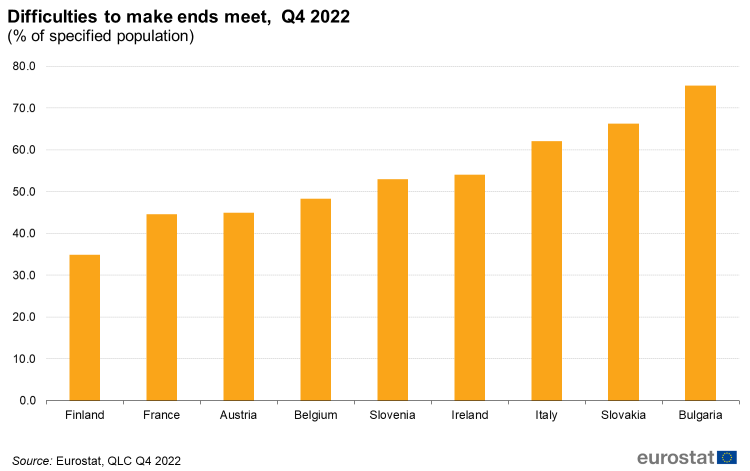
Source: Eurostat, Quarterly data collection on living conditions Q4 2022
This article is a part of Statistics Explained articles that are based on the quarterly data collection on living conditions (QLC). This new quarterly data collection has been developed to provide more information about living conditions of people during the COVID-19 outbreak and the recovery period. This article presents the results for Q4 of 2022 for nine EU Member States (Belgium, Bulgaria, Ireland, France, Italy, Austria, Slovenia, Slovakia and Finland).
Full article
At least one in every three persons facing difficulties to make ends meet
One important indicator for analysing the financial situation of households is the 'ability to make ends meet' indicator which shows whether a household has enough financial resources to make ends meet, which subjectively describes the overall financial situation of the household (income, wealth, expenditure and purchasing power changes due to inflation).
In Q4 of 2022, the share of the population that could make ends meet with great difficulty, with difficulty or with some difficulty was higher than 50 % in half of the countries. The highest value was observed in Bulgaria (75.3 %) and Slovakia (66.3 %) and the lowest in France (44.6 %) and Finland (34.9 %). Over the four quarters of 2022, an upward trend was visible for Finland, Austria, Belgium and Slovenia. In comparison with Q3 of 2022, the share increased in five countries and decreased in four.
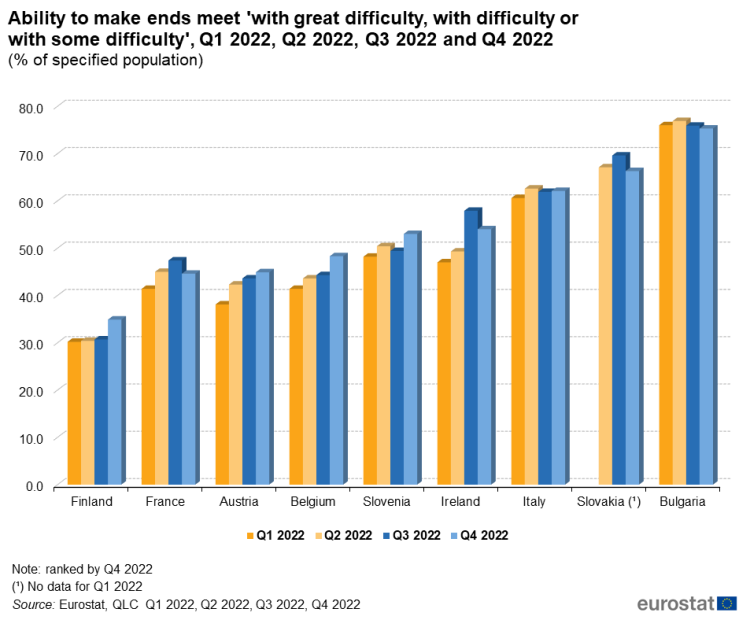
Source: Eurostat, Quarterly data collection on living conditions Q4 2022
Majority of population has stable income
Change in ability to make ends meet is one of the indicators that allows the analysis of the financial situation of households. Another indicator is the change in net household income. The net income does not take into account the changes in purchasing power and price inflation. In Q4 of 2022, the majority of the population reported that their household income remained more or less the same during the 12 month period preceding the interview. The share was higher than 40 % in all countries for which data are available. The highest values were observed in Bulgaria (71.6 %) and Belgium (68.2 %) and the lowest values in Finland (55.3 %) and Austria (44.1 %).
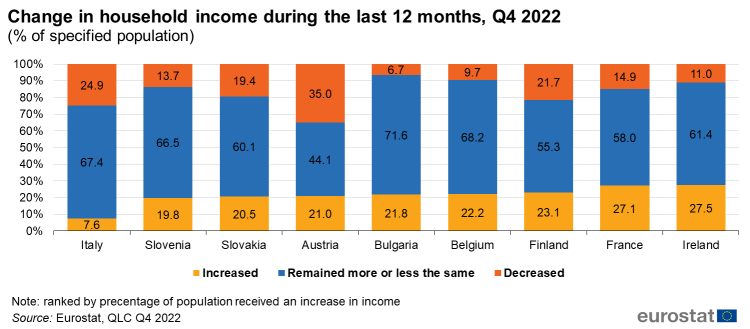
Source: Eurostat, Quarterly data collection on living conditions Q4 2022
In Q4 of 2022, the share of the population that indicated an increase of household income (during the last 12 months) ranged between 7.6 % and 27.5 % among the participating countries. In comparison with Q3 of 2022, the living conditions of the population remained rather stable. The percentage of population that reported an increase in income, decreased by more than 1 percentage point (pp) in Finland (2 pp) and France (2 pp). The share increased by more than 1 pp only in Ireland (4.6 pp).
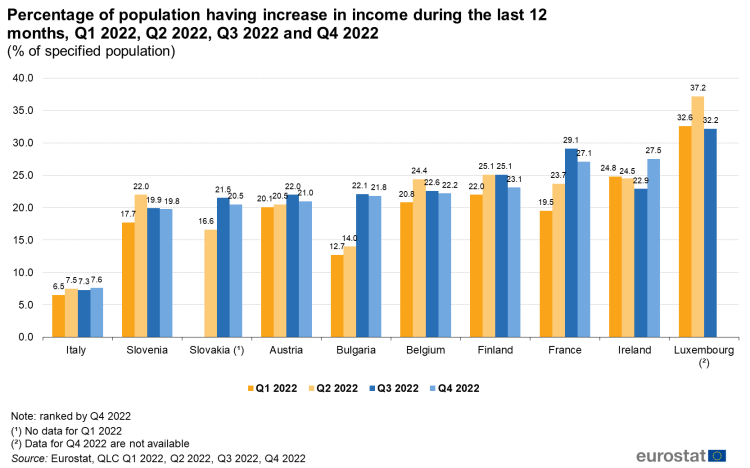
Source: Eurostat, Quarterly data collection on living conditions Q4 2022
At the same time, in Q4 of 2022, the percentage of the population that declared a decrease in income during the last 12 months varied from 6.7 % in Bulgaria to 35.0 % in Austria. In most countries, the percentage of the population with an increase in income was higher than the percentage of the population with a decrease. The only exceptions were Austria and Italy where the decrease of income was greater than the increase. In comparison with Q3 of 2022, the share was stable in most countries. However, the share increased by more than 1 pp in Finland (6 pp), Slovakia (8.2 pp) and Bulgaria (1.2 pp). The share of population with a reduction of income decreased in Austria, Italy, Ireland and Belgium but the decrease was lower than 1 pp in all of them.
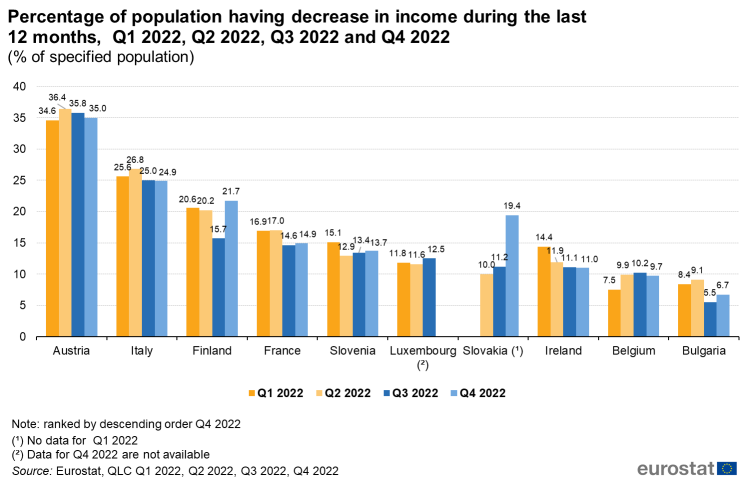
Source: Eurostat, Quarterly data collection on living conditions Q4 2022
Main methodological notes
The COVID-19 pandemic situation highlighted the need for timely short-term data on social inclusion and living conditions. On this basis, Eurostat and the EU Member States developed a new flexible approach for a new quarterly data collection on living conditions. This approach is based on a modular design and can be implemented in any existing (host survey) or new quarterly national data collection.
The new data collection includes two types of information: core variables of interest and background socio-economic variables. The core variables include information about the evolution of the household income, quality of life and financial difficulties. These 15[1] variables provide information about quarterly living conditions of the population; 11 are collected at household level while four are collected at individual level.
The background socio-economic variables contain information about the age, sex, education attainment level, activity status, household composition and other characteristics of the population. Data are collected using a variety of methods: paper-assisted personal interview (PAPI), computer-assisted personal interview (CAPI), computer-assisted telephone interview (CATI), computer-assisted web interview (CAWI) or with other appropriate methods. The core variables of interest are collected directly from the respondents (use of administrative sources is not allowed). By contrast, administrative data can be used for the background socio-economic variables.
The statistical population pertains to private households and all persons composing the household in the territory of the particular country. Persons living in collective households and in institutions are generally excluded from the population. The table below gives an overview of the host survey for each of the eight countries covered by this article and of the associated target population. In this article, the upper age boundary is set to 64 years old.
Source data for tables and graphs
Data sources
The data in this article are based on new quarterly data collection of living conditions. A total of 11 EU Member States (Belgium, Bulgaria, Ireland, France, Italy, Luxembourg, Hungary, Austria, Slovenia, Slovakia, Finland) joined in the first stage of data collection covering the period of 2021-2022.
Context
The main objective of the new quarterly data collection on living conditions is to provide timely information on living conditions of households and household members. This information should fulfil the need of quarterly data on the particular field. The initiative was launched in the middle of 2021 and it is expected to deliver important data for monitoring the recovery after the COVID-19 crisis.
Direct access to
Other articles
Main tables
Dedicated section
Legislation
Regulation (EU) 2019/1700 of the European Parliament and of the Council of 10 October 2019 establishing a common framework for European statistics relating to persons and households, based on data at individual level collected from samples (IESS regulation)
Notes
- ↑ The number may vary from country to country.
